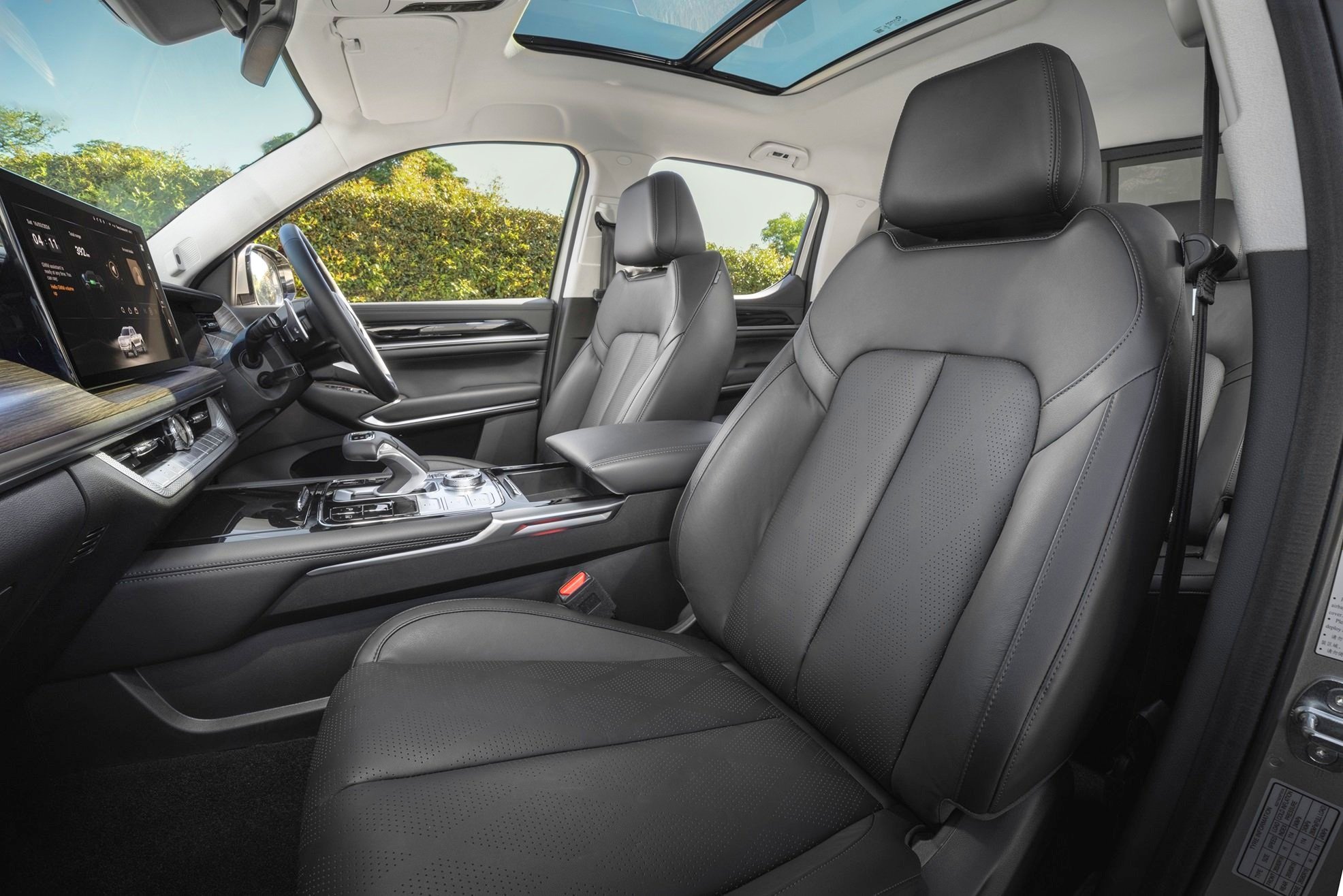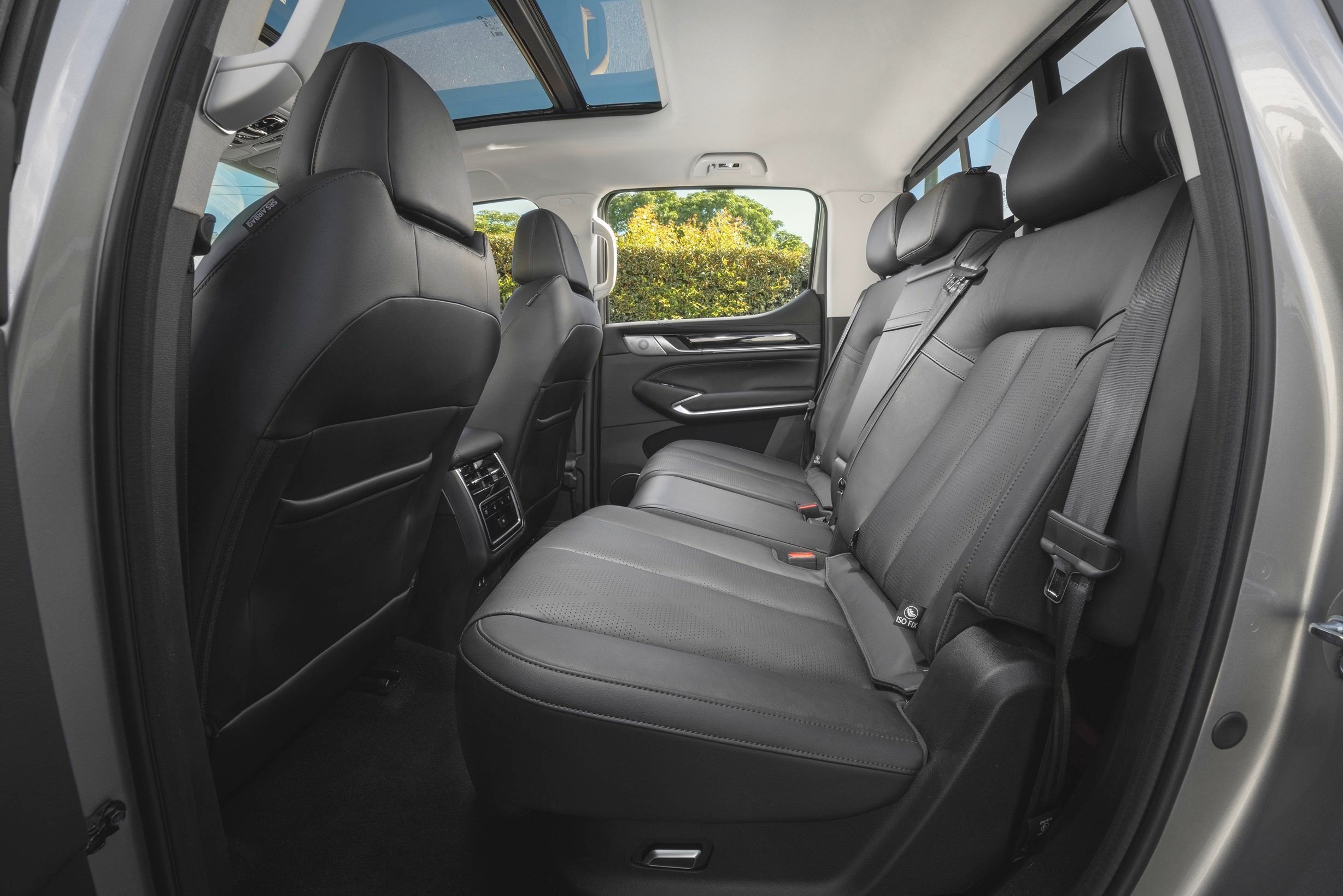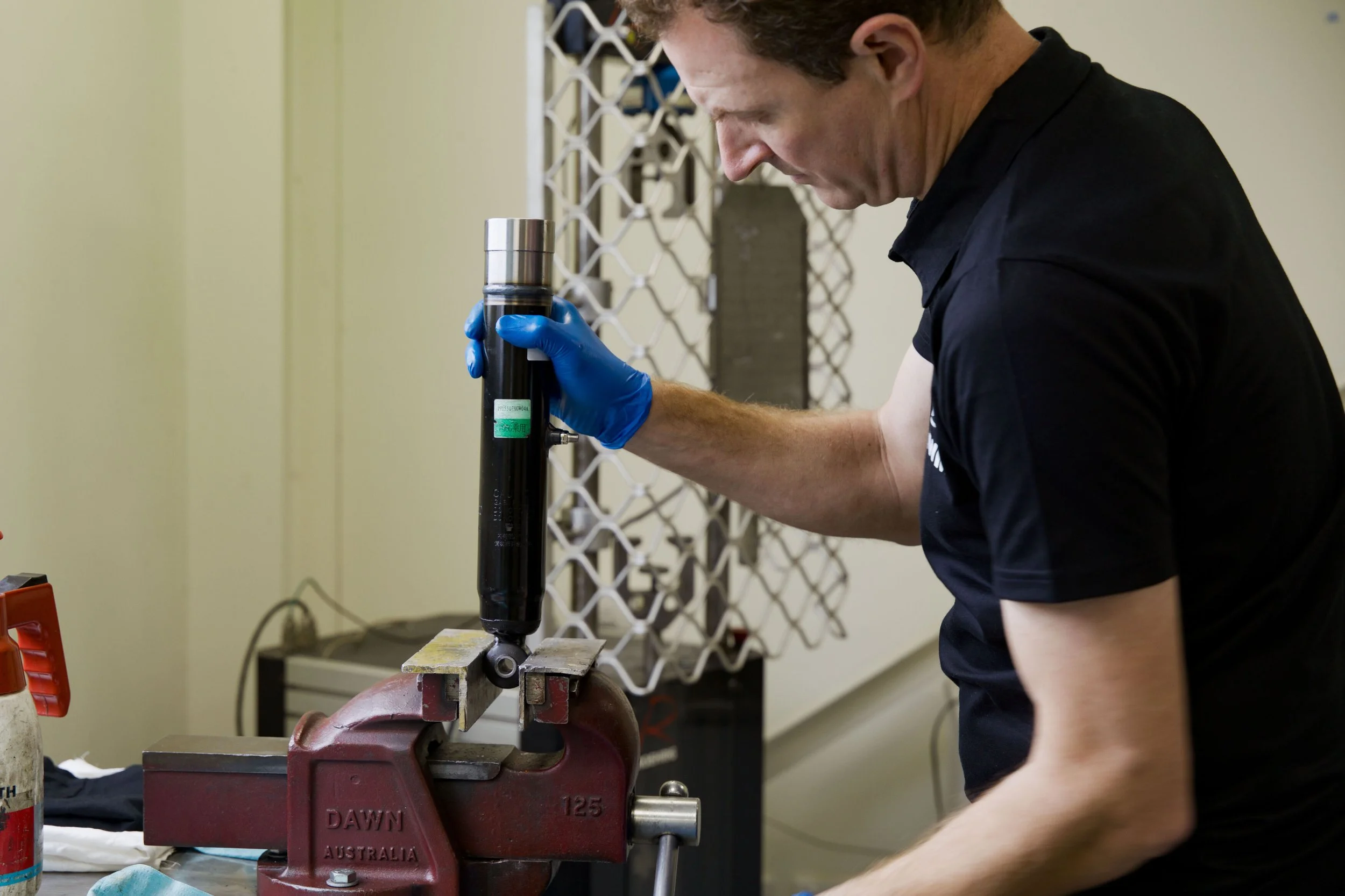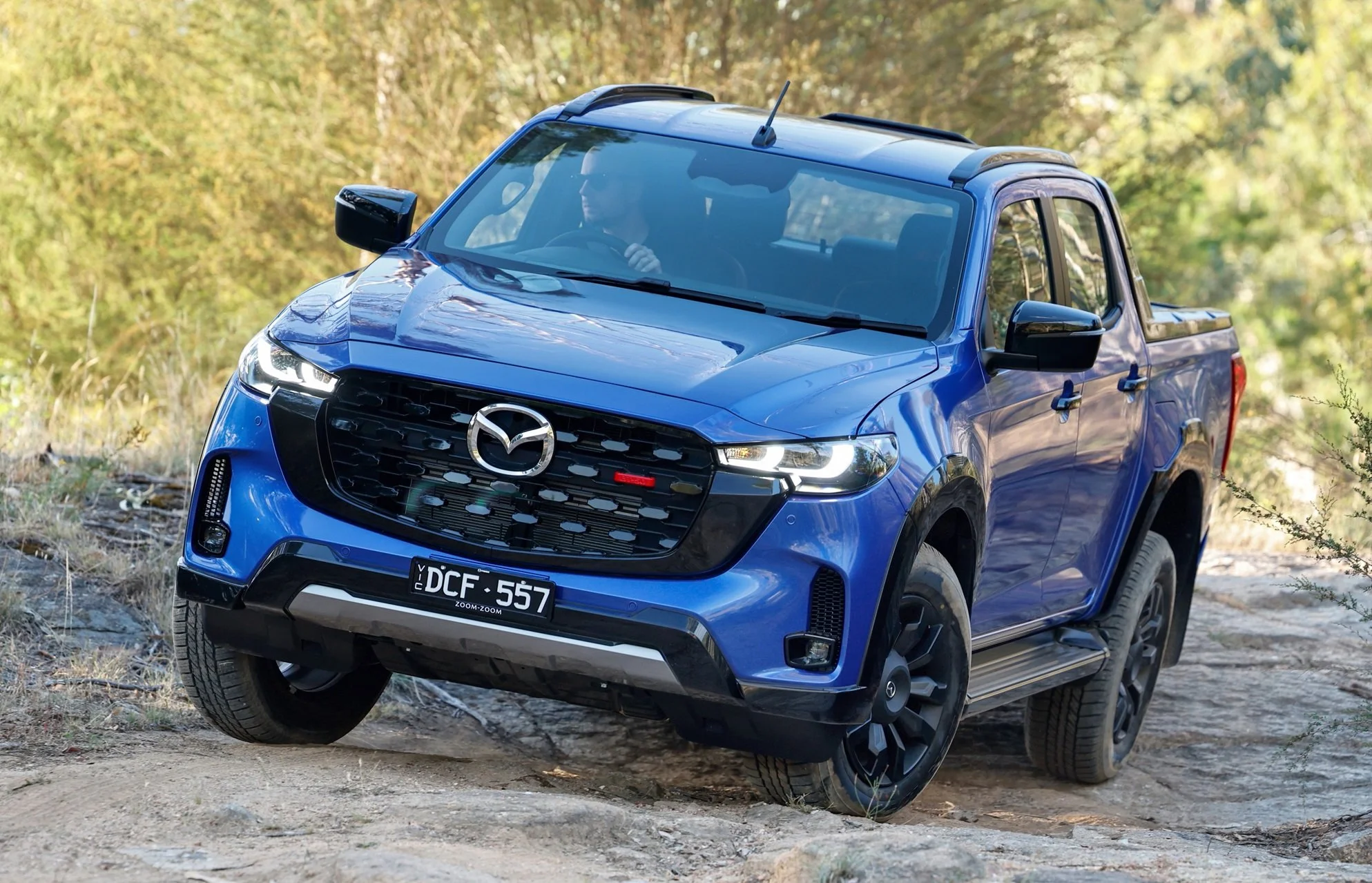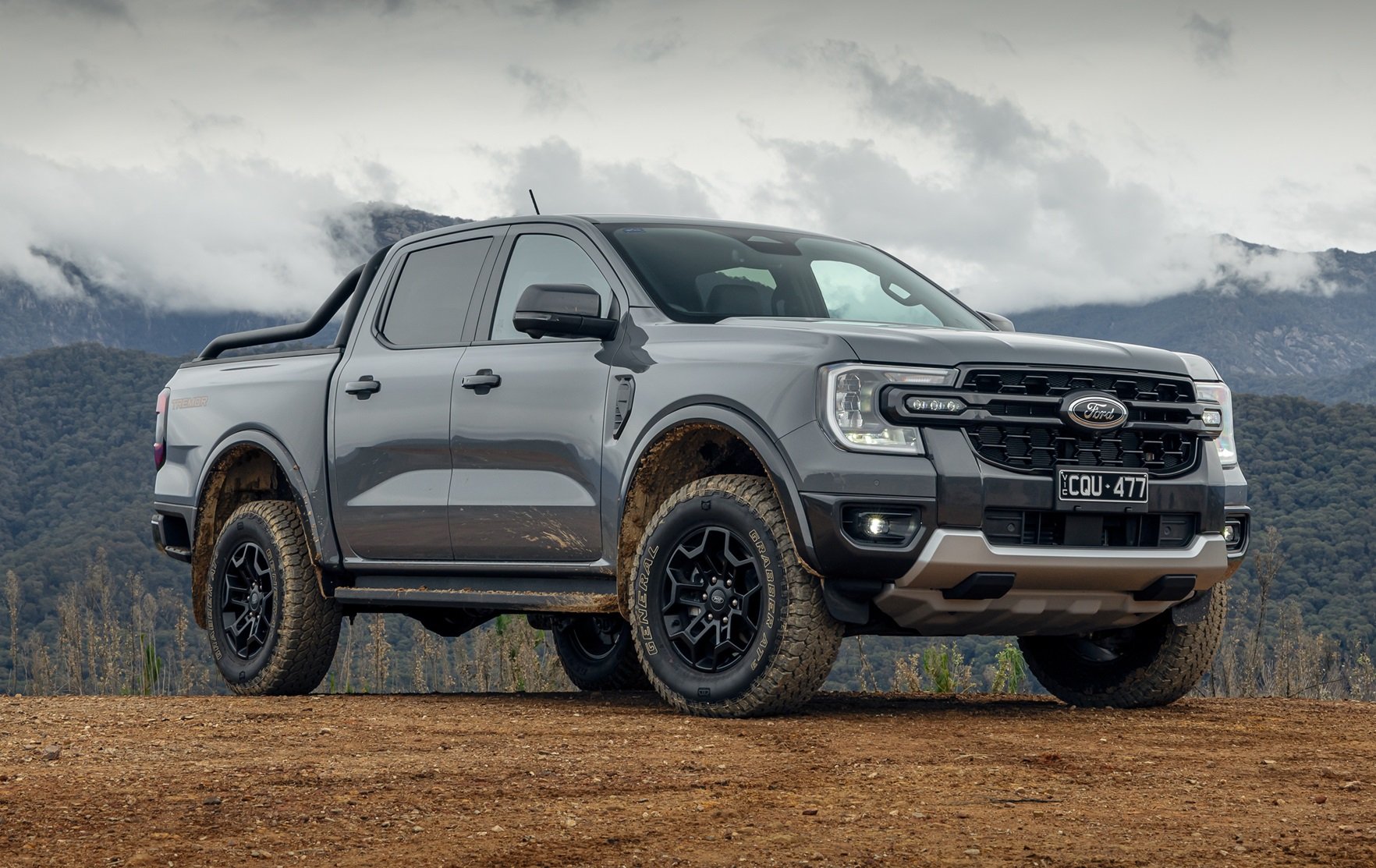GWM Cannon review and buyer's guide
Just because a ute is cheap, that doesn’t mean it’s worth the money. Is the GWM Cannon more than just a cut-price Ranger wannabe? Can it offer towing, off-roading capability and robust design to compete with the big brand dual-cab utes like Hilux and Triton?
The GWM Cannon is a high-value dual-cab ute that wants you to think it’s a Ford Ranger for two thirds of the price, but with all the same equipment and capability. But is it, and does it?
While it certainly has the price to entice you away from the established brands like Toyota Hilux, Ford Ranger and Mitsubishi Triton, there are questions you need to ask of GWM and the Cannon before dropping up to $50,000 on the wrong ute.
You can download the official GWM Cannon spec sheet here >>
It’s one thing to offer a cheap dual-cab ute, and it’s a completely different thing to design one that is $15,000-$30,000 cheaper than the competition. After all, that’s what Mitsubishi has been doing with the Triton GSR for the last six years or so against the Ford Ranger Wildtrak, and that’s exactly the same as what GWM is doing to them.
The fact the Cannon XSR is being offered at a flat $50,000, some $15,000 or so less than a top-shelf Triton, means you’re likely to be tempted by a dual-cab ute that could mean multiple home loan repayments worth of cash stays in your bank account. So the question you need answered here is whether this is too good to be true, or too good of an opportunity to pass up.
Let’s help you figure that out.
The Cannon is 5439mm long in XSR form. That’s 119mm shorter than a Triton GSR and it’s 69mm longer than a Ranger Wildtrak. The Cannon’s 3230mm wheelbase, which directly relates to cabin space for passengers, is also comparable in so far as it’s just 40mm (4cm) less than the Ranger and just 100mm (10cm) less than the Triton. Meaning: you’re probably not going to notice any tangible difference in interior legroom. But you’ll notice a bigger number of money going toward Mitsubishi or Ford, than for the Cannon.
However, there are distinct advantages in paying those extra thousands to have a Triton or Ranger, which go beyond just how big the vehicle is or how much legroom you have. And it’s not just about having badge credentials.
Both Triton and Ranger have the capacity for on-road all-wheel drive by engaging a centre differential (in the case of Triton) or an electromagnetic clutch (in the Ranger) which enable you to operate both vehicles in ‘4H’ on sealed or good quality roads where the level of grip is compromised such as gravel roads or in wet weather.
The Cannon XSR offers a big tray, a reasonably grunty turbo-diesel 4-cylinder engine, four-wheel drive, and decent towing capability. It even offers both a front and rear locking differential - but it cannot perform this on-road all-wheel drive trickery without the risk of basic driveline ‘wind-up’.
If you’re looking for a dual-cab ute that isn’t necessarily the best at a particular thing, but is competent at most of the mundane tasks you need a ute to do: tow a bit, carry a bit, perhaps access some sketchy back road, maybe do a bit of light off-roading from time to time, take the family camping etc - it’s hard to see how a Cannon won’t be able to do those jobs.
This particular iteration of the Cannon is an updated version of the same platform GWM launched in 2021, which is why it retains the 2021 ANCAP-issued five-star safety rating which involved less-harsh protocols the Triton was subjected to in 2024. More on that later.
Let’s look at what you get on each model grade and what that costs at each tier.
FEATURES & PRICING
GWM Australia recently announced it would also offer a new base model, which they’re calling the Premium, and it comes with a smaller 2-litre engine as well as being available in a single-cab 4X2 ($35,500 d/away) and 4X4 dual-cab chassis model. This will be perfect for fleet buyers.
The Lux also now comes with a cab-chassis style tray in its normal dual-cab form.
CANNON PREMIUM | $39,500 driveaway (approx.) | 2.0-litre turbo-diesel engine | dual-cab (4X4)
12.3-inch infotainment touchscreen (wireless Apple CarPlay& Android Auto)
6 speaker audio with DAB+ digital radio
Front & rear USB outlets (USB-A / USB-C)
7-inch digital driver’s display
4-way steering column adjustment
Electronic park brake with auto hold
Automatic rain-sensing front wipers
Paddle shifter
Multi-function steering wheel
Push-button start
Manual-dimming rear view mirror
Adaptive cruise control (ACC)
Remote engine start (key)
Roof rails
Spray-in bedliner
Chrome sports bar
Power fold exterior mirrors
Tailgate dampener / struts
Central locking with tailgate locking
LED rear fog lamp
CANNON LUX | $40,500 driveaway (approx.) | 2.4-litre turbo-diesel engine | dual-cab (4X4)
DRIVING
Reversing camera
Rear parking sensors
Tyre pressure monitoring system (TPMS)
Follow me home lighting
Electronic park brake with auto hold
Automatic rain-sensing front wipers
Paddle shift
Multi-function steering wheel
Push-button start
Remote engine start (on keyfob)
INSIDE
Faux leather seats + steering wheel
Driver 6-way manual adjustable seat
Front passenger 4-way manual adjustable seat
60:40 rear seats with centre armrest
Single zone climate control with rear outlet
Wireless phone charger
3 x pre-wired 12v accessory buttons
Auto up/down driver’s window + anti pinch
12.3-inch infotainment touchscreen
Wireless Apple CarPlay and Android Auto
Bluetooth
Voice command
TECH
Auto emergency braking
Blind spot monitor
Lane: keeping, centering, departure warning, emergency keeping
AEB junction assist
Front collision warning (pedestrian + cyclist)
Door open/vehicle approach warning (DOW)
Traffic sign recognition
Traffic jam assist
Intelligent turning
Smart dodge
Rear collision warning
Rear cross traffic alert with brake
Emergency signal system (indicators)
Driver fatigue monitoring system
OUTSIDE
18-inch chrome alloy wheels
Chrome sports bar
Auto LED headlights with DRL + electric levelling
Auto high beam
Fog lights with steering illumination
LED taillights
Sequential LED indicators
Front grille – machine grey
Power fold exterior mirrors
Side steps
Roof rails
Shark fin antenna
Tailgate dampener / struts
Central locking with tailgate locking
Body coloured wheel arches, door handles, mirror caps
Spray-in bedliner
Smart keyless entry (front)
CANNON ULTRA | $43,500 driveaway (approx.) | 2.4-litre turbo-diesel engine | dual-cab (4X4)
It adds…
DRIVING
Auto-dimming rear-view mirror
360° rearview camera
Front parking sensors
INSIDE
Leather accented seats
Front heated / ventilated seats
Heated steering wheel
Power windows – auto windows + anti pinch (all)
Driver 6-way power adjustable seat
Front passenger 4-way power adjustable seat
USB port for dash camera
Ambient lighting
Front footwell lamp
OUTSIDE
Electric sunroof
Tailgate step
Rear privacy glass
CANNON VANTA| $45,500 driveaway (approx.) | 2.4-litre turbo-diesel engine | dual-cab
OUTSIDE
18-inch black alloy wheels
Black sports bar
Black side step
Matt black, front grille, wheel arches, mirror covers, door handles
Yes, this is effectively just a ‘black pack’ treatment with the exception of the sports bar and side steps, which do add tangible value, but they’re nothing unique - except for the price, obviously.
CANNON XSR | $50,000 driveaway (approx.) | 2.4-litre turbo-diesel engine | dual-cab
What’s really interesting about the XSR is that you get to, effectively, pay more for less. But hold on, it’s not what you might think. Whereas in a low-slung Italian sports car you pay more for less in terms of a lighter vehicle made with more exotic materials, what happens with the Cannon is you get less invasive, distracting pseudo safety equipment - but not because GWM is choosing to turn its back on ANCAP’s safety rating.
It’s because, apparently, “due to the exterior design” that features like lane keeping and lane change assist aren’t available. But it does mean you lose rear cross traffic alert, rear collision warning, door open/vehicle warning, s blind spot detection and smart dodge. These are potentially good features to have. So it’s a win/lose situation, like everything in life.
But the XSR does give you, in addition to the Vanta model grade:
OUTSIDE
Unique XSR front grille
Snorkel
Side step (metal - they don’t specify which kind of metal)
Body coloured door mirrors and door handles
DRIVING
Drive modes: Standard, Mud, Sand, 2H, 4H, 4L
INTERIOR
The Cannon gets an enormous 12.3-inch touchscreen infotainment screen to join all the other giant touchscreens that feature wireless Apple CarPlay and Android Auto.
There’s no binnacle or shading of the screen in any manner, thanks to its slapped-on design, but GWM is hardly the first carmaker to stick one of these things onto their dashboard without any in-depth consideration for the sun and how reflections and glare work here in Australia.
Fortunately, you get a wireless phone charging pad and old-school recharging options USB-A and -C ports, including in the rear seats where there’s also vents for air conditioning which is dictated by the front.
Ventilated (cooled) seats are available in the Ultra model grade which is a welcome inclusion that you won’t find in any of the established-brand dual-cab utes, even an $80,000 Ranger Wildtrak. And the Ultra is half the price of a Ranger Wildtrak.
When GWM says you get a “free-standing” 7-inch digital driver’s display cluster, what they should be saying is they couldn’t be bothered putting the screen underneath any binnacle or awning or some kind of crude shading device, much like the central touchscreen. But here’s hoping both screens have enough brightness to compensate - but don’t hold your breath. Also, there needs to be said something about how incessant heat on the back of these touchscreens will affect long-term reliability.
Othwerwise, you need to ask yourself, for good or bad, do you like a minimalist interior in your dual-cab ute? Because that’s more-or-less what you get in the Cannon. It feels like a slightly upmarket SUV interior rather than the typical function-first wannabe cockpit-turned spaceship type of interior design you might be used to in things like Tritons, Ranger, Hiluxes and so on.
Depending on your perspective, you might also think the Cannon’s interior is stylish in a plain and simplistic, even functional way. If you’re not the sort of person who likes to tweak and fiddle and play with every switch and button, it might actually suit you down to the ground.
Let’s be honest, when GWM says its clean, fuss-free cabin is about:
reducing the number of buttons and dials for easier access
what they’re really talking about is reducing the number of individual button components and wiring they have to produce. If they were genuinely all about making things easier to access, they’d introduce more buttons (not less) and be less reliant on the central touchscreen for menus and submenus to ‘access’ functions. Pilots don’t use enormous 20-inch touchscreens with laggy software to fire up an Arbus A-380. They use missile switches, rocker switches and toggles.
GWM Australia says the transmission selector is an “aviation-inspired gear shifter”. That’s more effort than you could say Mazda went to with the BT-50 or Toyota has put into any of its products. But after this transmission shifter, that’s kind of where the uniqueness stops.
It’s a fairly bland interior, all things considered, and it’s a curiosity whether the minimalist thing works in a dual-cab ute. Does it? Perhaps inoffensive is a better description. It’s modest, yet the analogue clock thing, as seen on the LandCruiser Prado lookalike Tank 500 is a swish touch, particularly for a ute - available on the
What does work well is the multiple storage areas for tape measures, keys, 10mm sockets and tax receipts. There’s reasonable space in the door bins, there’s transmission tunnel nooks ideal for bits and bobs, the usual phone holder tray fore of the shifter suits the majority of big slab phones, and a central storage tray under the lip of the centre console will be ideal for holding onto your breakky wrap while you get your seatbelt on.
In the rear seats there are two sets of ISOFix points and a top tether anchor point for each pair of ISOFix, unlike plenty of other others where you get a clear sign of the carmarker cheapening out by fitting one centralised top tether anchor point. You can also split-fold the rear seats in a 60:40 fashion, again unlike the bigger-name utes which generally only drop the entire seatback. In the same manner you can also flip up the seat bases to fit bulky items like moving boxes.
A sliding rear window offers another option for cabin ventilation as well as being able to pop random items into the cabin from the tray or vise versa. Unfortunately, there are no cupholders in the centre armrest for kids who will have to rely solely on the bottle holders in the doors. Too bad for any adults with coffee cups back there.
I'll help you save thousands on a GWM Cannon
Just fill in this form.
No more car dealership rip-offs.
Greater transparency.
Less stress.
ENGINE
Gone is the under-powered 2-litre engine the Cannon was laboured with back in 2021. Instead, you now get a 2.4-litre single turbo-diesel four-cylinder engine, making 135kW of peak power at 3600rpm and 480Nm of torque between 1500-2500rpm.
Having a kerb weight of 2330kg means you’re left with a power-to-weight ratio of 57 kilowatts per tonne, which might be a 3 per cent increase in grunt compared with the asthmatic 2-litre unit in the pre-2025 Cannon. But it’s 22 per cent down on power compared with the more conservative 150kW output of a Triton (70kw/t) and it’s 36 per cent down on the 78kw/t you’ll find in the 184kW Ranger Wildtrak.
Considering that the Triton also uses a 2.4-litre capacity, albeit with a bi-turbo system instead of the GWM’s single unit, you’re also getting a 9 per cent better claimed fuel economy figure on the Mitsubishi at 7.7 litres per 100km compared with 8.4 on the Cannon.
Despite claiming an extra 10Nm of torque for the Cannon, GWM Australia hasn’t actually stated at what revs the engine is making its peak power. So there’s a good chance they’re just spinning the engine faster than Mitsubishi is at 1500-2750 RPM to make its 470Nm.
If we factor in the Cannon XSR’s payload limit of 875kg (995kg if you opt for the Lux, Ultra or Vanta), the Triton has a notional 910kg limit, but weighs 7 per cent less.
This should give you some perspective on how impressive the Cannon is, but also where it lacks the fundamental grunt and underlying capability of a ute like the Mitsubishi Triton. And that certainly doesn’t mean it’s terrible - in fact, it’s quite the opposite. The fact a supposedly upcoming brand like GWM (on its second or third ute model now in 150 years), getting this close to an established brand like Mitsubishi on paper is a feat in itself.
But it also serves as a reminder about how meticulously something like a Triton is developed to be powerful enough, but also not over stressed to the point of becoming unreliable; and yet it’s substantially more affordable than its more powerful Ranger competitor.
If you simply don’t need the steel side steps, the snorkel and the black trimmings, the Vanta or Ultra are excellent value considering you lose the extra weight those accessories added, meaning you gain performance back. But losing that front diff lock is a tangible compromise.
TRANSMISSION
Cannon gets a 9-speed conventional torque converter automatic transmission, which GWM says is a unit compact enough that it takes up no more space than a standard 6-speed, and is capable of handling “up to 750Nm of output”. Big deal: carmakers do this routinely with components; testing them for a much higher durability than their intended use - that how you make something reliable. You overengineer it.
The BorgWarner transfer case and electronically activated rear differential (standard on 4x4 models) and a front differential (XSR only) allow for off-road use on low-traction surfaces.
But, while you get 2L, 4H and 4L ratios for the transfer gearbox, you don’t get any kind of centre differential that, like Triton and Ranger, would offer you on-road use in grip-limited conditions like heavy rain or gravel roads. So you’ll be sticking to two-wheel drive on sealed roads which kind of sucks if you’re towing a trailer in heavy rain, or navigating a steep driveway with the tool trailer on or backing a caravan up a gravel slope.
You do get all-terrain drive modes even modes are available, including Normal, Eco and Sport on the Lux, then if you go for the XSR you add the pre-programed Snow, Mud, and Sand settings which adjust the traction control and throttle input to suit those conditions.
TOWING
Sure the Cannon has the same 3500kg braked towing capacity as the competition, and a 350kg towball download limit allows 10 per cent of the trailer to be borne by the tow vehicle. That’s all good. Although don’t go towing 3500 kilos routinely with a Cannon, or any dual-cab ute for that matter, unless you appreciate the inherent risk you’re taking towing a trailer capable of unsettling the prime mover (your ute) on the wrong corner.
The payload is decent at 995kg for the Lux - Vanta model grades, and even 875kg for the XSR is commendable against its mainstream rivals. With a GVM 3225kg for the Lux, Ultra and Vanta and 3205 for the XSR (thanks to the addition of those factory-fitted accessories) these are pretty respectable numbers for a vehicle notionally $20,000 cheaper or more than some of the most popular vehicles in Australia.
With a 6200kg gross combination mass, and weighing 2.2 tonnes (almost the same as a Ranger) you should expect it’s going to be a winner for towing. There are some unknowns here in relation to the rear suspension, but not because GWM has done what Nissan did with Navara by using coil springs. Fortunately, that calamity has been avoided. Cannon has a live axle, that’s fine, typical of the breed, and it also uses coil springs, thankfully. (That could’ve been an easy cost-cutting measure.)
What we don’t know is the longevity of that rear suspension setup in relation to carrying 900+ kilograms, and towing over 3000kg. Getting the rear suspension right with leaf springs, however agricultural as they may be, is a bit of a dark art.
The fact is, brands like Mitsubishi, Ford and Toyota don’t make utes that buckle under this kind of sustained pressure, certainly not on unsealed roads for long periods of time. It remains to be seen how durable a Cannon is going to be long-term under this kind of load without things like spring holders failing, welds breaking, the springs actually being able to cope with Australia’s notoriously bad roads, with a bunch of gear in the tray, a family on board and a notional 2500kg trailer pushing down on the towbar.
Is another 15kW (over the old 2-litre engine) enough grunt to move out from behind that truck on the freeway to overtake it in 40-degree heat with the AC cranked, the luxury camper being hauled along behind and all your camping gear strapped down in the tray? A Mitsubishi Triton in its previous generation was regarded as being underpowered with ‘only’ 130kW up until it was superseded by the current model with 150kW.
In a Cannon, it seems, you’re just going to have to be a bit more patient and wait for that dedicated overtaking lane instead.
DRIVING
If you’re only at the investigation stage of which ute you might consider buying next, as opposed to needing to buy one urgently, it might be worth taking into consideration the next iteration of GWM Cannon.
This is because serious fundamental, yet incremental changes are coming to GWM products thanks to recent news the company was locally hiring former Holden ride and handling engineer Rob Trubiani, and his old Holden stomping ground, the Lang Lang Proving Ground.
So GWM Australia will be picking up the mantle from the now dead GM Holden by developing ride and handling suspension and steering tunes for its products. Making public statements like “GWM’s key local engineering base” mean the brand is not just making a fleeting marketing gesture, they’re committing to a pathway that means their vehicles will no longer subscribe to that stereotypical presumption of ‘cheapness’.
So don’t be surprised to see an updated Cannon ute in the next 18 months that might just be one of the nicest handling utes on the market, with the potential of upsetting the Ranger-led apple cart in terms of on-road handling.
Until that happens, you’ll be glad to know the current Cannon goes okay for any dual-cab ute designed and built in a market outside of Australia and not primarily for the Australian road conditions.
It’s a bit jarring over bumps and potholes when unladen, but once you put tools and supplies in the back, the leaf springs take that load and it translates into a much more compliant ride
The engineering requirements for a dual-cab ute aren’t the same as a typical family car but still rely on the same fundamental physics principles. They just need to account for bigger payloads, meaning the dampers (and the fluid inside them) works harder, the springs need to be more robust and all the steering and suspension architecture allow for that.
But on our roads and for our consumer base, utes need to be better than just miniature trucks. They are also used heavily as passenger transport, and our roads are uniquely poor in terms of quality and frequency of being repaired.
Thanks to our unique combination of very hot summers where the bitumen melts and heavy rain slowly washes away the soft oils, our roads also become particularly hard to the point of turning brittle. Our vehicles are typically quite heavy, our economy relies heavily on lots of big trucks, and that pummels the road surface even further. And because of our relatively low and sparse population, we have a very far-reaching road network with long stretches between major cities and regional towns.
So vehicle suspension here is unique in that it needs to carry heavy loads, on especially hard, broken roads, in the heat, for long periods of time, and they need to be reliable.
So if you can make do with a Cannon ute just driving around the city with supplies and gear in the tray and perhaps a tool trailer on the back, it’s probably going to be quite fine on the relatively nice roads around suburban Melbourne Sydney, Brisbane, Canberra, Adelaide, or Perth. And probably also in big regional towns.
But if you’re thinking about taking a Cannon ute on the Big Lap of Australia, in the longer term, it might be better to wait and see how the next generation of locally fettled Cannon.
FUNCTIONALITY
With its considerable length you’ll want to be careful in carparks and low-speed manoeuvres, and with approach and departure angles of 30 and 26 degrees respectively, in XSR variant it’s going to clear all the same rocks, logs, shelves and river entry/exit points as a Triton, Ranger or Hilux. Things will be a little closer on the lower model grades.
The slightly wider turning circle of 13 metres is going to make tight three-point turns that bit more awkward either in the suburbs, driveways, carparks and building sites, or indeed when trying to position yourself off-road.
Having a longer wheelbase than Triton and Ranger, the Cannon will have that in-cabin legroom advantage, but it will mean a reduced breakover angle thanks to the wheelsets being that little bit further apart when clearing a sharp crest or embankment.
Not only is the 1.52-metre tray longer than a Ford Ranger and narrowly shorter than the Triton and BT-50, it’s also got a retractable tailgate step (rated to 120kg) that makes clambering up into the tray much easier than without one.
There are also corner steps moulded into the rear bumper, and tie-down loops in each of the four corners of the tray. Exactly how hard to can ratchet down on them is a matter you might want to investigate. If you can preference securing things via the sports bar, that’s going to be a much sturdier anchor point.
Think of the GWM Cannon a bit like if Isuzu had actually made its previous generation D-Max not a jittery, wriggly, extremely stiff and unrefined tractor-with-aircon. The Cannon is like a last-gen D-Max without all the noise, vibration and harshness that made that vehicle terrible to use every single day, either as a private vehicle or a fleet workhorse.
What’s interesting is the prospect of how good the next all-new Cannon will be if they’ve already outdone Isuzu’s best efforts from 10 years ago. Say what you might about Chinese brands, but they’re right behind the Thai-built Japanese brands… and gaining.
DRAWBACKS
The primary issues with the Cannon have been a lack of power, unfinished suspension tuning and steering calibration that makes it light and easy at low speeds and when driving off-road, but becomes hard work at normal road speeds.
It’s a dark art trying to get a dual-cab ute in the Goldilocks zone. It has to be as good as it can possibly be on-road, because that’s where the majority of the driving is going to be done, and it needs to be able able to carrying significant payload and remain compliant while doing so, and then it has to be completely bi-polar and handle all the undulations, ruts, and intensity of Australia’s smashed-up bush tracks.
Utes are no longer allowed to be terrible to drive on-road and awesome off-road, and nor can they simply get away with being dynamically astute and responsive on-road but fall apart the moment they hit the gravel and mud. And it needs to be said that GWM simply does not have the decades of tuning wizardry magic (what engineers would call data) that gives them a cheat sheet headstart for developing their trophy truck - unlike Ford, Mitsubishi Toyota, Isuzu and even Nissan to a certain extent.
But it needs to be said that GWM has absolutely caught up very quickly in the matter of a decade. In 2015, their best effort was the Great Wall Steed and that thing was appalling. Today, the Cannon has a five-star safety rating, four-wheel disc brakes, it handles okay both on- and off-road, the cabin is reasonably comfortable and the build quality is nipping at the heels of the Japanese - without that final polish.
In addition, and for what it’s worth here, it’s all the little niggles that the big brands have long baked in that GWM needs to tick off to make the next Cannon a properly lethal opponent in the dual-cab sales arena. Things like not having cup holders in the second-row armrest, the lack of power to go with those big payload/towing claims, the IKEA-quality tiedown loops in the tray, the rear tailgate step that is too narrow for a typical boot to stand on safely without slipping.
It’s a nice idea having that rear step, but it’s flimsy and not robust enough for the typical 100-kilo Aussie bloke to use 20 times a day for the next five years without it snapping off, or getting mud jammed in the rails, or whatever. But the step itself simply isn’t wide enough; it’s so narrow there isn’t actually any room to plant your size-13 Colorado while carrying a bag of concrete. It’s a gimmick, at best.
Lastly, the Cannon doesn’t have a centre differential (or some technical equivalent) which would offer on-road 4-high use in traction-limited driving environments like heavy rain, slippery slopes or good quality gravel roads. This is going to become a staple in future utes and was pioneered by the Mitsubishi Triton 10 years ago.
When you’re towing two tonnes or more, especially in the always-heavily-laden situations most tradies find themselves in day-in-day-out, being able to get around in 4H can be the difference between getting home in one piece or worse.
Power: 150kW @ 3500 RPM | Weight: 2170 kg (kerb) | Power-weight ratio: 70 kW/t | Ground clearance 228mm | Wading depth 700mm | Payload (GSR) 910 kg | Tray length 1555 mm | Tray width 1135 mm (b/w arches)
PRO: Clever centre diff and all-wheel driveline allows high-traction surface use such as wet bitumen (unlike most other 4X4 utes), excellent value ($15K cheaper than Ranger equivalent), competitor rivalling towing capacity, more frugal than most comparative utes, new bi-turbo engine design seems quite reliable in-service.
CON: Driver stalking camera alert system needs to be less distracting (ruins an otherwise near-perfect ute).
Comment:
If you want the best fuel economy, equal towing capability, all-wheel drive 4H use on sealed roads (but in poor driving conditions) but you also want good brand support while also being a whopping $15,000 cheaper than the equivalent Ranger - Triton is unrivalled.
The nice wide tray is ideal if you have landscaping supplies to haul, while a good turning circle of 12.7m makes it more manoeuvrable than Cannon and Ranger. Triton also has a DEF exhaust fluid/AdBlue tank to treat the nastiest particles before they emit into the air.
Triton is also the only ute to be tested against the latest, more burdensome crash testing protocols, and yet can also offer a comfortable, practical interior that caters to both long-distance touring and daily-driver tradie commuter practicality.
CLICK HERE FOR MORE ON MITSUBISHI TITON >>
KIA TASMAN:
PRO: Premium interior, lots of modern equipment, 4A all-wheel drivetrain, affordable mid-spec variants, excellent customer support, factory-fitted brake controller, widest tray among rivals
CON: Lacks higher torque output of rivals for extreme towing, looks splay-eyed
Comment:
Tasman might have taken an eternity to finally arrive, but now that’s it’s here, it’s going to prove a compelling value proposition against the Mazda BT-50, Mitsubishi Triton and possibly even the Isuzu D-Max. Tasman might have a lot to prove to ute buyers like yourself, but the fact an SX+ costs $1000 less and already offers equipment on a BT-50 GT costing $66K.
Tasman does lots of clever little things like print the vehicle’s dimensions under the centre console lid, comes with a built-in electronic brake controller which means you not only have that function when towing, but you also don’t have to deal with a third-party in terms of warranty. Early examples seem to show it’s quite proficient off-road and decent for plenty of moderate and heavy towing situations; maybe not the fastest or noisiest, but good enough for most conservative drivers.
CLICK HERE FOR MORE ON KIA TASMAN >>
MAZDA BT-50
Power: 140kW @ 3600 RPM | Weight: 2208 kg (kerb) | Power-weight ratio: 63 kW/t | Ground clearance 240mm | Wading depth 800mm | Payload (SP) 892 kg | Tray length 1571 mm | Tray width 1120 mm (b/w arches)
PRO: Pretty reliable, good dealer network, sublime interior that makes you enjoy sitting in it, lots of model grade choice (almost too much choice…)
CON: Convoluted model range no longer includes manual gearbox, old style 4WD system doesn’t allow 4-High on-road use
BT-50 is a smart, good-value choice when it comes to buying a dual-cab 4X4 ute that needs to work hard every single day of its life without needing ‘all the toys’. It’s thousands of dollars cheaper than the equivalent D-Max it’s based off, while having a much nicer interior.
The 2025 model update has given it a more aggressive front end without getting silly with wheelarch extensions, snorkels and big stickers. The BT-50 does have that fairly reliable, 25-year old Isuzu engine with decent power outputs and a fairly robust 4X4 driveline, only you don’t have to deal with Isuzu Ute.
CLICK HERE FOR MORE ON MAZDA BT-50 >>
TOYOTA HILUX
PRO: Excellent resale value, fairly reliable, lots of dealers
CON: Expensive model range, more primitive 4WD system doesn’t allow 4-High on-road use, new 48-volt system could be problematic
Comment:
Hilux is the oldest ute platform in this group - and by significant margin. The last time Hilux was given a substantive update was 2018, even though Toyota Australia has tried to sex it up with the ‘GR’ pack.
Hilux has the best resale value, but that’s hinged on their religious brand presence in Australia. It’s a fairly bland ute with little to distinguish it from the rest, and in fact relies on the same primitive 4WD system as D-Max whereby 4H cannot be used on-road.
CLICK HERE FOR MORE ON TOYOTA HILUX >>
FORD RANGER
PRO: V6 towing grunt, all-wheel driveline system, heavy kerb weight makes towing safer at speed
CON: Below-average customer support from Ford Australia, expensive range
Comment:
Ranger is undeniably the most masculine ute on the market, and it certainly gets an all-access pass to every building site, every High Country campground and has the towing cajones for mass market appeal.
The reliability isn’t as good as it should be, and Ford Australia needs to up its game in terms of customer service, but at least you can drive it in 4H on high-traction surfaces such as in heavy rain or good-quality gravel backroads. Ranger is also very expensive, making the Cannon look like a bargain.
CLICK HERE FOR MORE ON FORD RANGER >>
CONCLUSION
There’s absolutely no reasonable argument against the fact that the GWM Cannon is insanely good value - especially if you don’t need a hardcore 4X4 ute to push to the edges of its technical limits.
Although, on the other hand, maybe it’s exactly the right 4X4 ute for doing exactly that - thrashing within an inch of its life on the gnarliest off-road terrain you can find is certainly going to be more fun in a vehicle that costs just $50,000 instead of $65,000 or indeed $80,000.
So in many respects, while it doesn’t have the grunt to compete with the most popular vehicle in Australia on towing and load-carrying fundamentals, the Cannon absolutely challenges the status quo in terms of what defines good value.
If you need a 4X4 dual-cab ute to use at 5-7 tenths during the week and take the family away with on the long weekends, it;s probably going to be quite okay at that. It won’t be exceptional, or even as polished or multi-role capable in the same way a Ranger Sport or Triton GSR will be when towing heavy stuff in the pouring rain up steep hills, or overtaking trucks on 40-degree days with the payload near-maxxed out and the air-con on 11.
But if you just want a ute to throw stuff in and tow with here and there, it’s undeniably one of the best value utes you can buy in 2025. The funny thing is, Ford, Toyota, Mazda and Mitsubishi will never admit that this is true.


